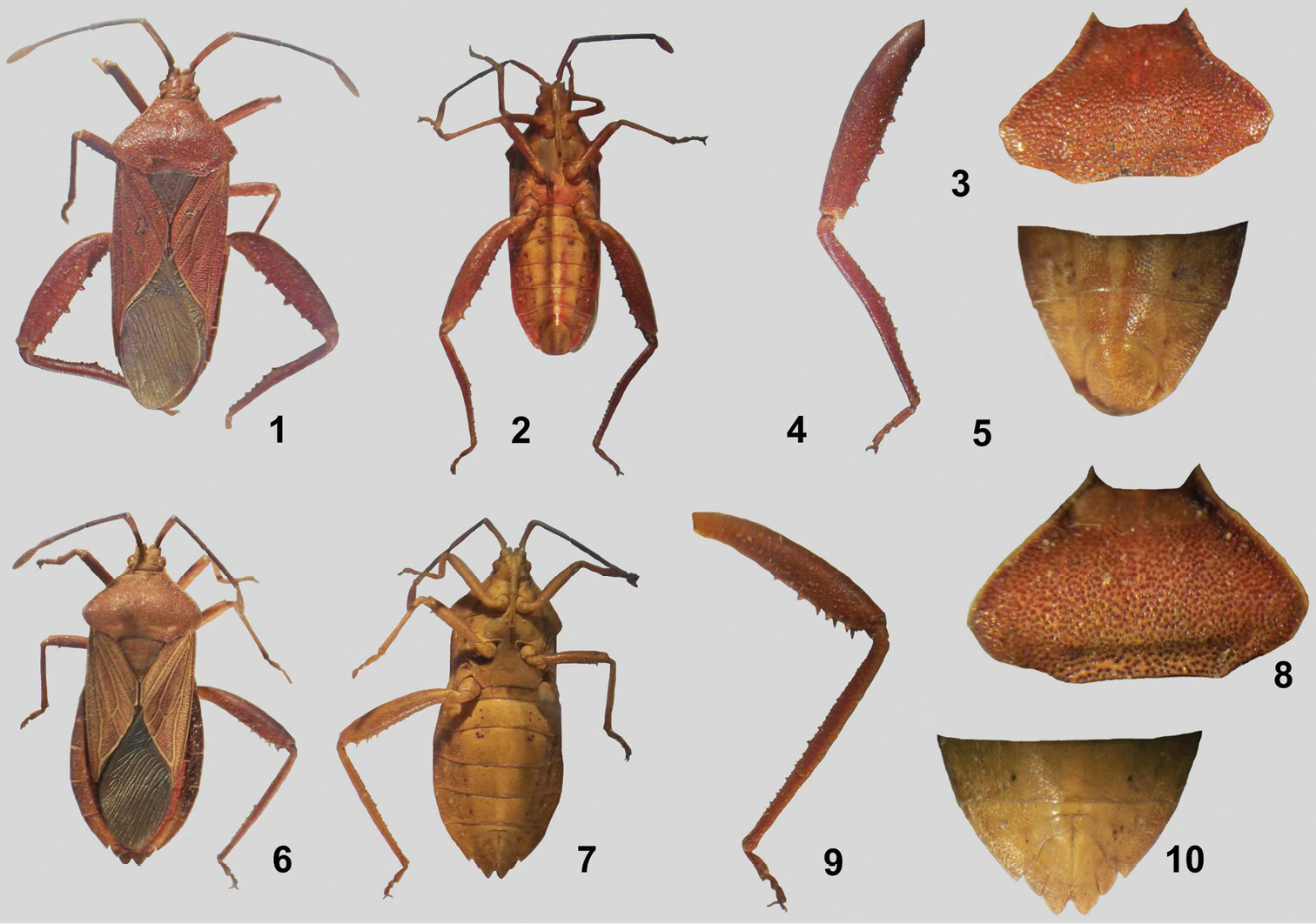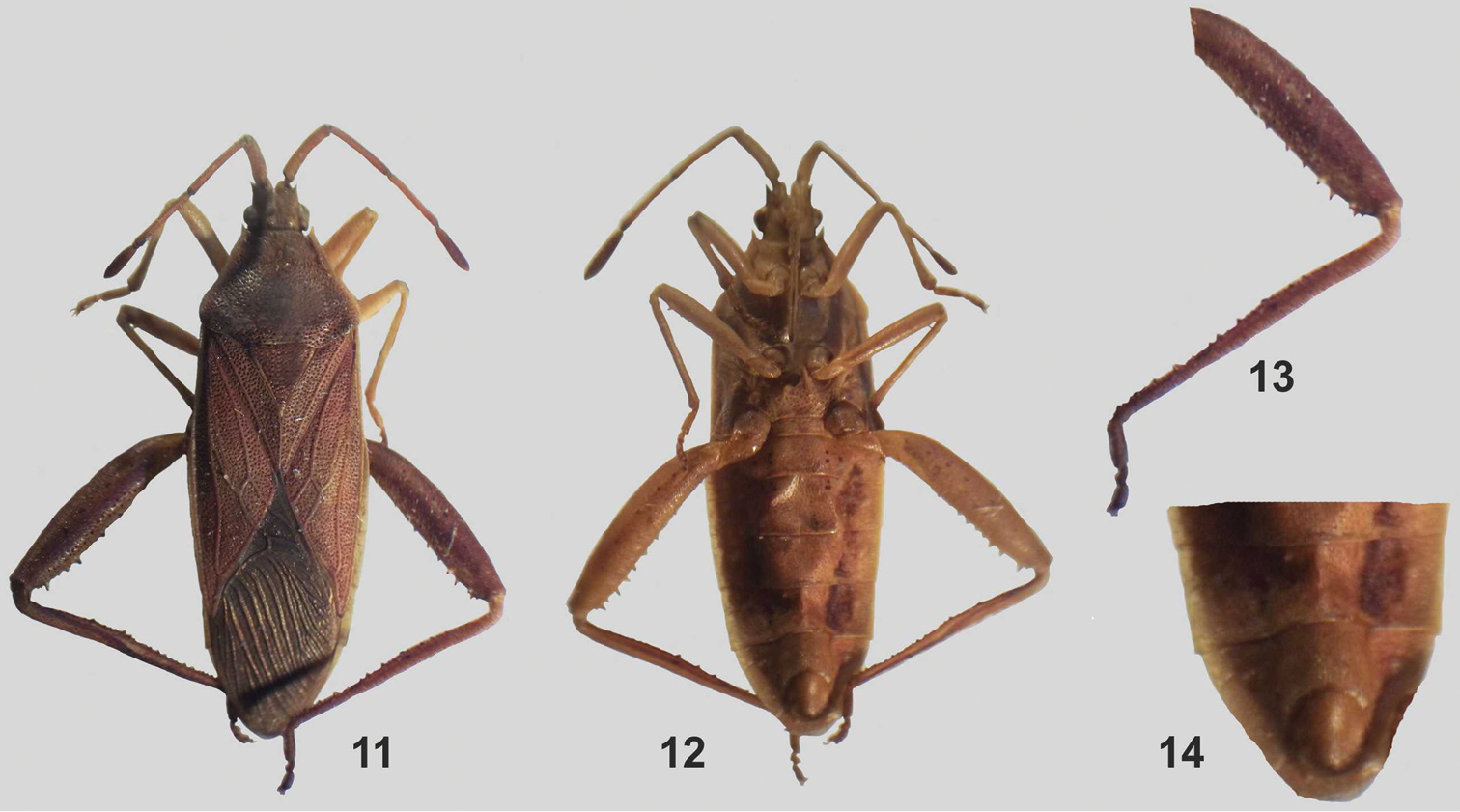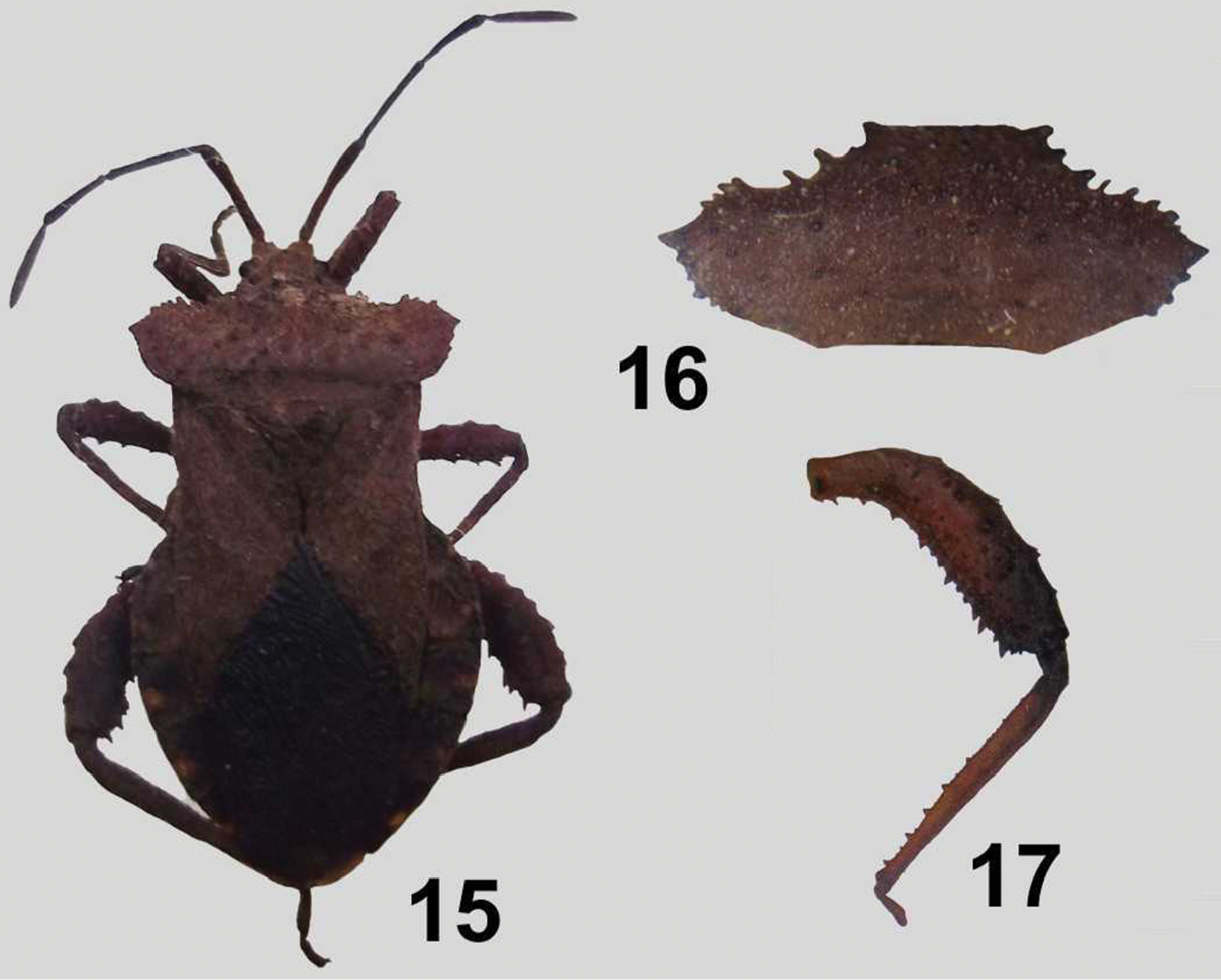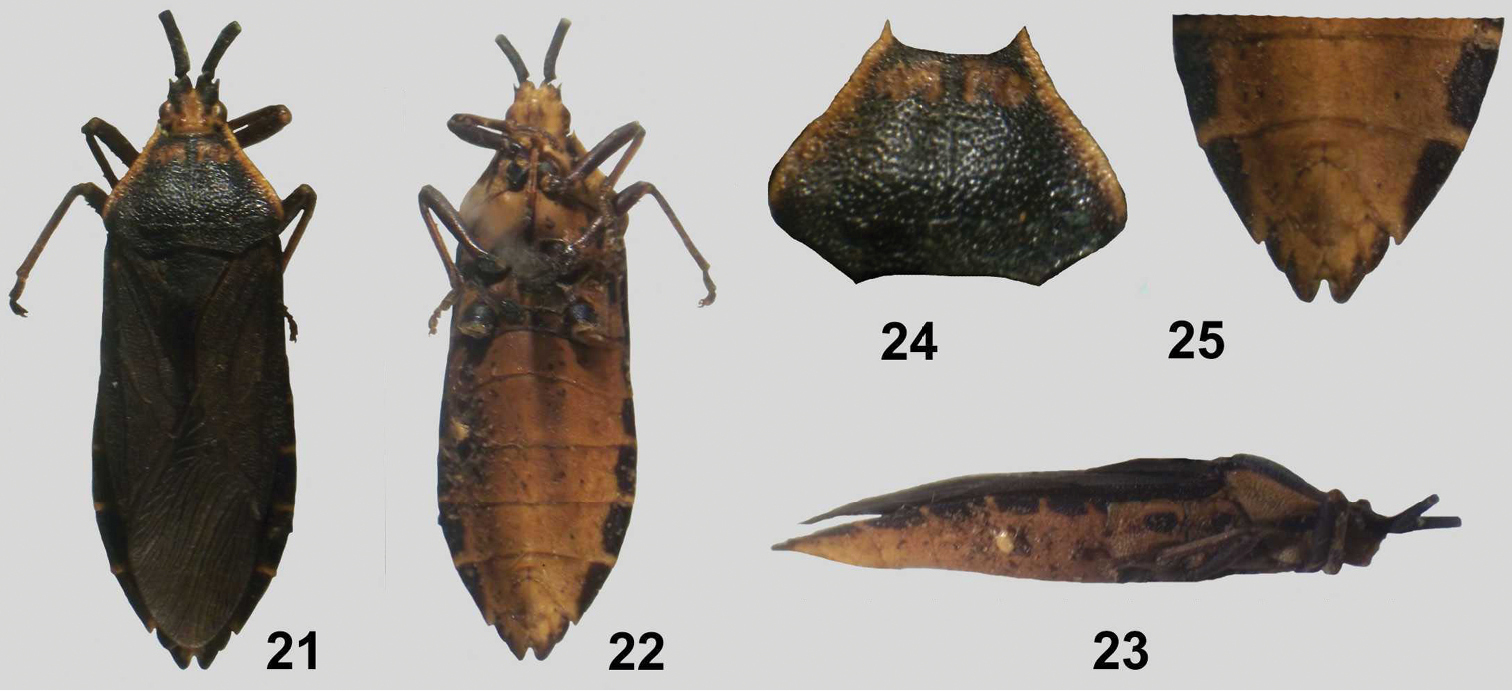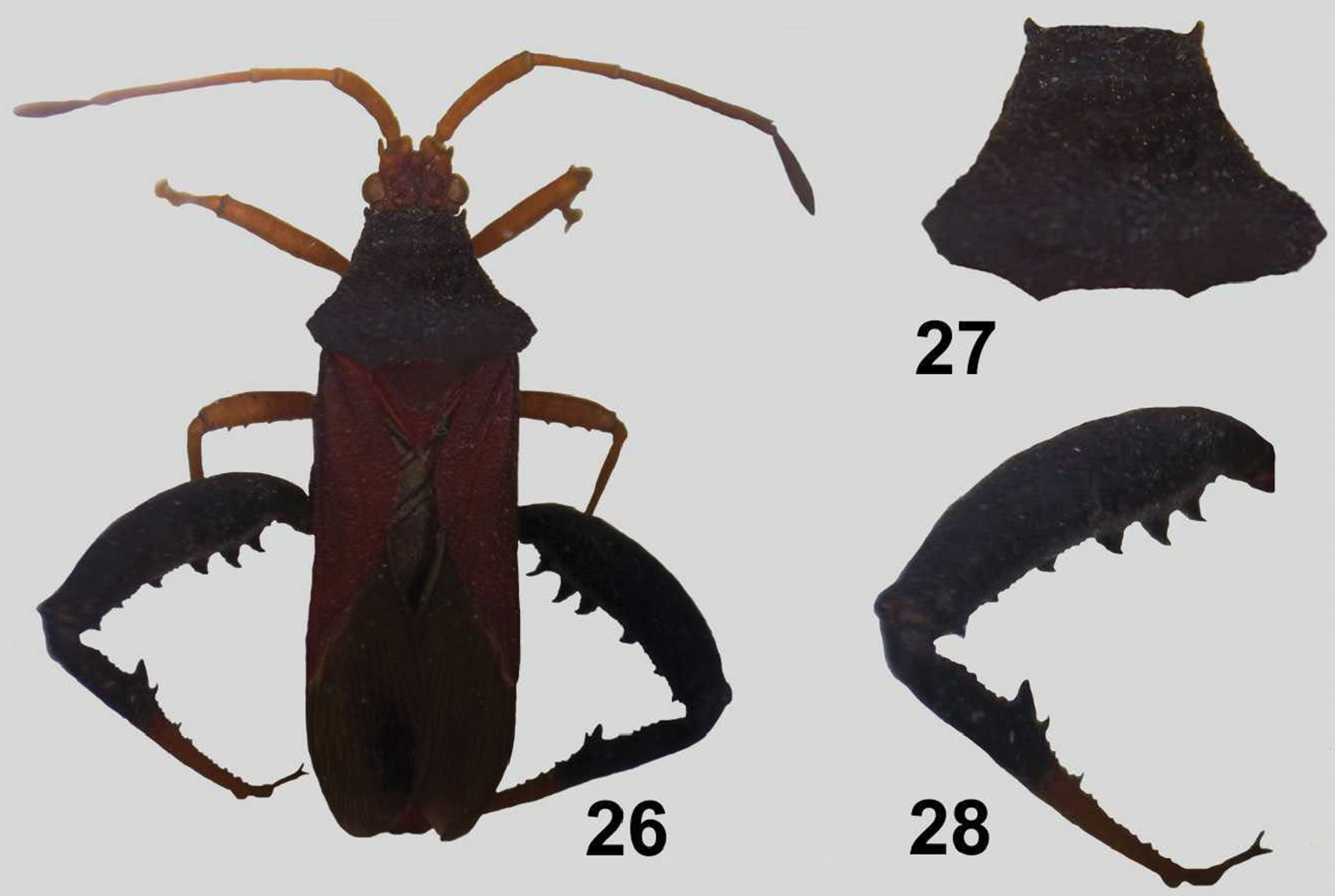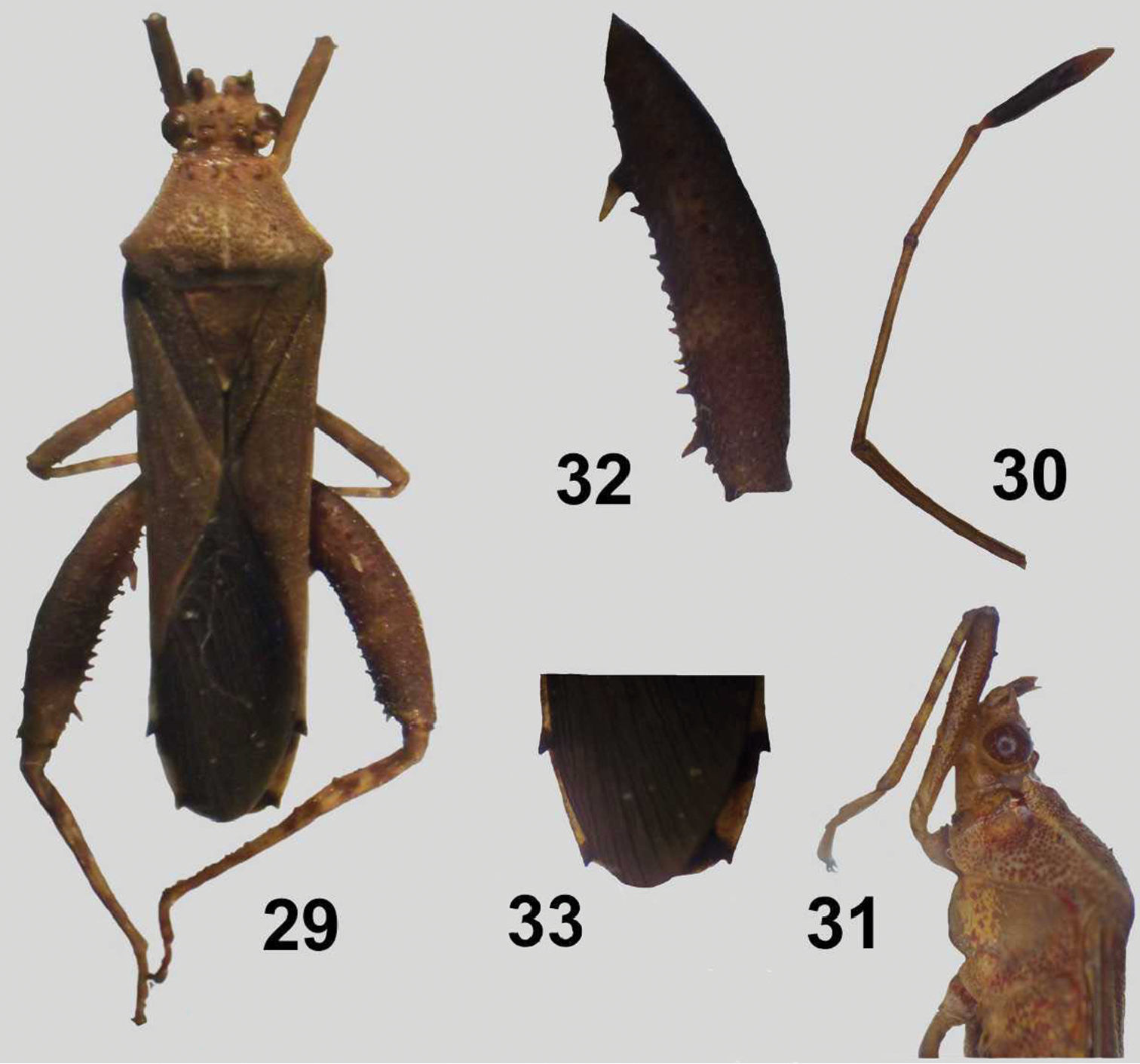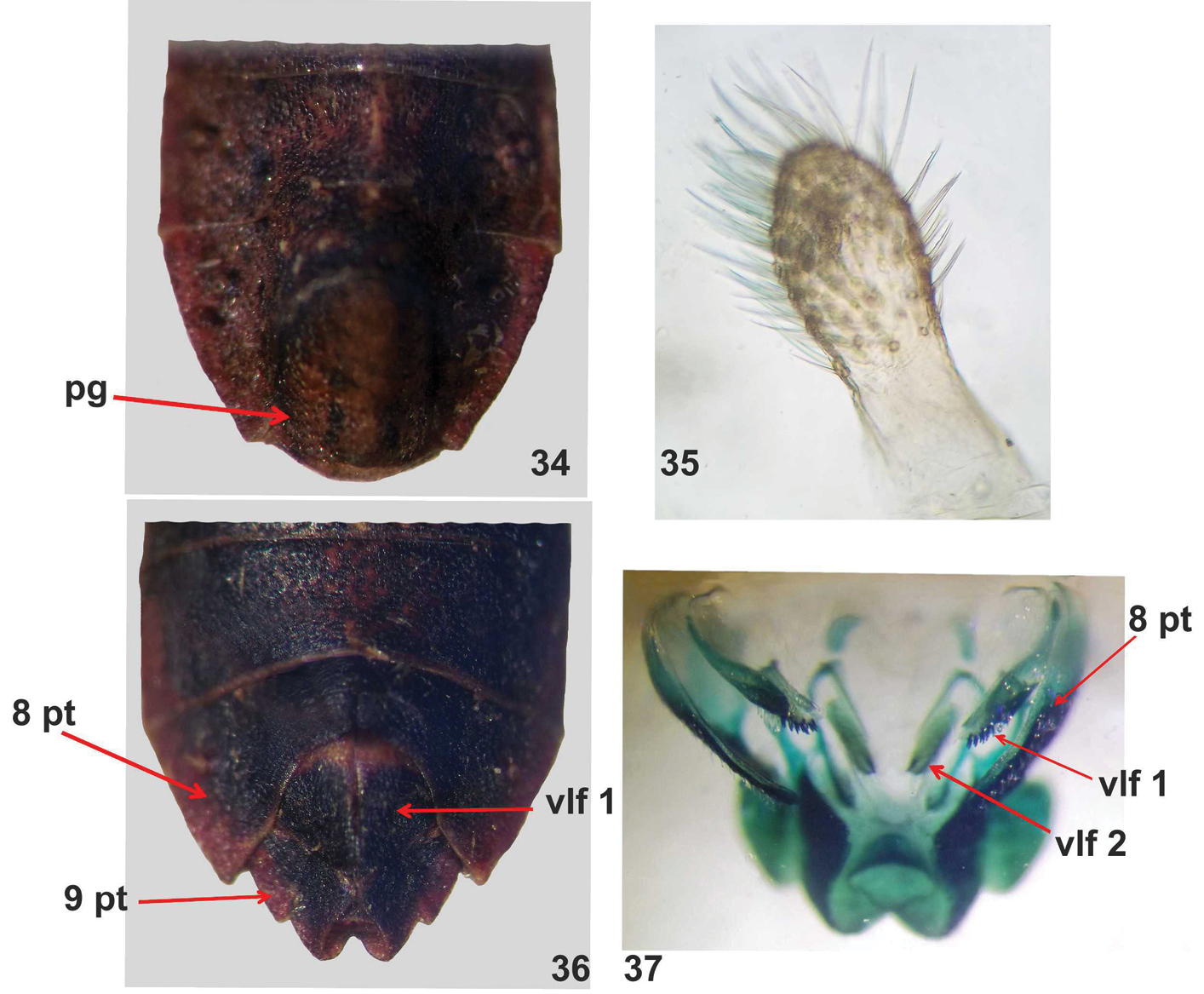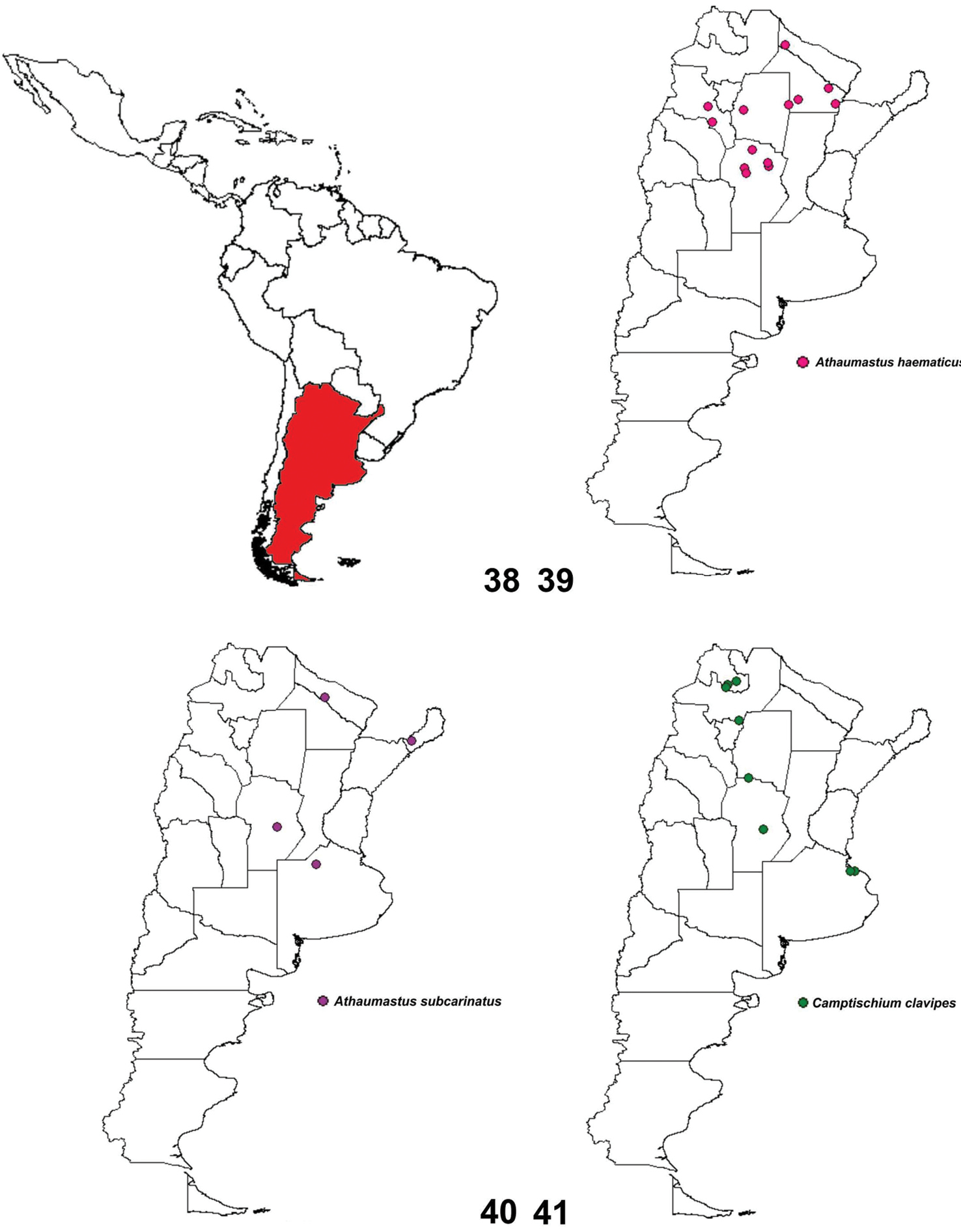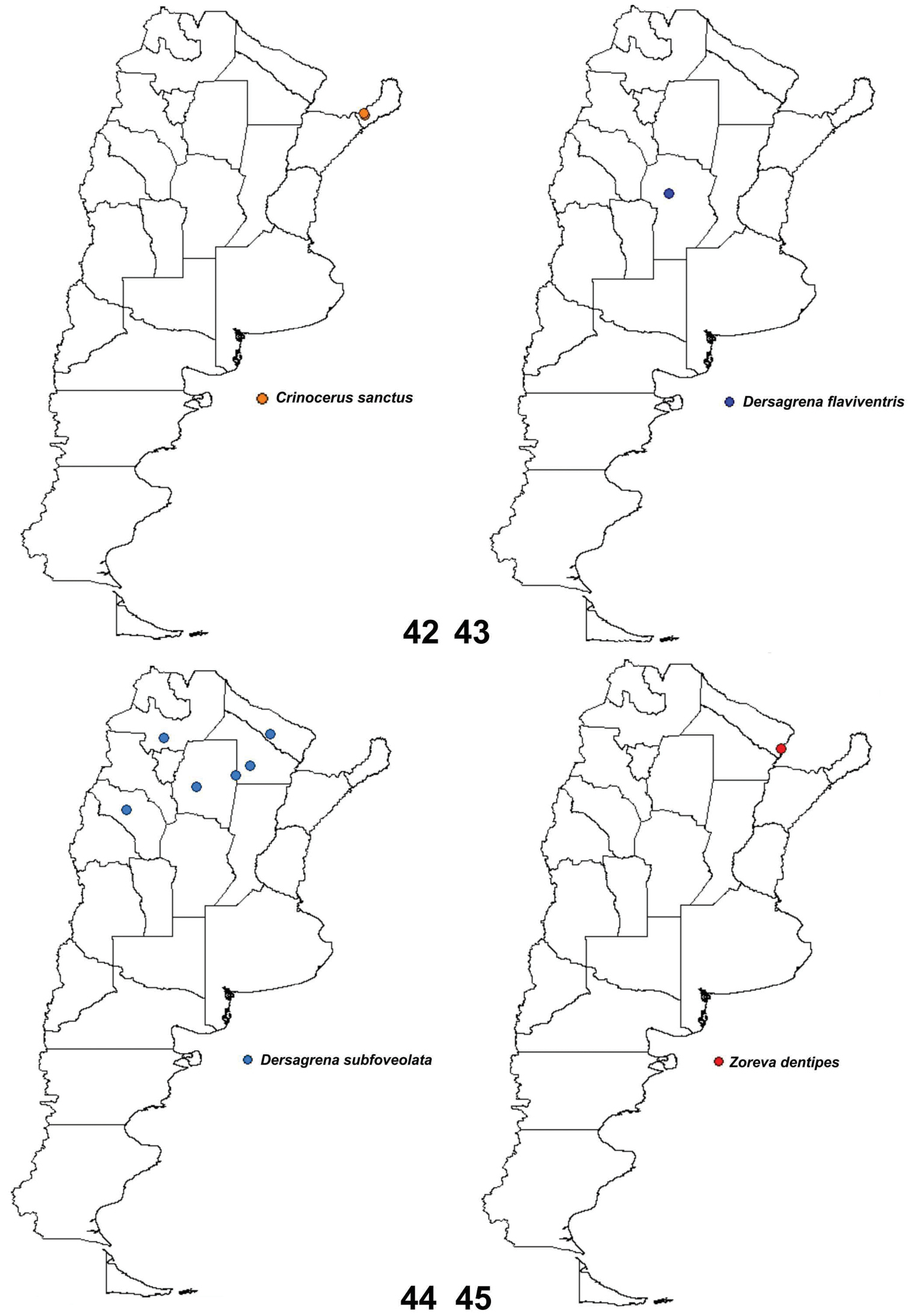






(C) 2013 José Luis Pall. This is an open access article distributed under the terms of the Creative Commons Attribution License 3.0 (CC-BY), which permits unrestricted use, distribution, and reproduction in any medium, provided the original author and source are credited.
For reference, use of the paginated PDF or printed version of this article is recommended.
Eight genera and 13 species of the tribe Acanthocerini are recorded in Argentina, i.e., Athaumastus haematicus (Stål), Athaumastus macer Brailovsky, Athaumastus subcarinatus (Stål), Athaumastus subterlineatus Bergroth, Beutelspacoris sanchezi Brailovsky, Beutelspacoris dilatata Casini, Camptischium clavipes (Fabricius), Crinocerus sanctus (Fabricius), Dersagrena flaviventris (Berg), Dersagrena lacerdae (Signoret), Dersagrena subfoveolata (Berg), Thlastocoris hernandezi Brailovsky and Zoreva dentipes Fabricius. Redescriptions are given for Athaumastus haematicus, Athaumastus subcarinatus and Dersagrena flaviventris with photographs of male and female genitalia of Dersagrena subfoveolata. Zoreva recorded from Argentina the first time. New locality records are given for Buenos Aires, Chaco, Formosa, Misiones, and Tucumán.
Acanthocerini, genera, Argentina, key, redescription, distribution
The Coreidae, commonly called “leaf-footed, pod- or squash-bugs”, are heavy bodied insects usually strongly elongate or broadly elliptical. This family includes some of the largest living heteropterans, as well as species that are delicate or slender (
The most comprehensive treatment of the Coreidae for Argentina are by
Many coreids are of great economic importance. As mentioned by
Knowledge of the South American fauna is poor; this is especially true in regard to economically important taxa. Comprehensive keys for identification of the species in the region have not been published.
Most of Argentina lies in the Neotropical faunal region. The country covers an area of 2, 791, 810 km2 and is bordered by Uruguay, Brazil, Paraguay, Bolivia, and Chile. Approximately 75% of the country is occupied by arid and semiarid areas, but rainforests are also present in the northeast, i.e., the Yungas and Paranaense regions. Coscarón (submitted) recorded 125 species in 48 genera of Coreidae living from Argentina.
The goal of this paper is to provide an illustrated key to the genera of Acanthocerini (Coreidae) from Argentina (Fig. 38), a diagnosis and redescription of some of its species, geographical distribution, and a list of species for each genus.
All specimens from this study are deposited in the collections of the Museo de Ciencias Naturales de La Plata (MLP), La Plata, Buenos Aires, Argentina (http://www.fcnym.unlp.edu.ar/abamuse.html). Photographs were compared with material of the Naturhistoriska Riksmuseet in Stockholm, Sweden (http://www.nrm.se/2.1286b10fdbe80efba80001.html) and the American Museum of Natural History in New York (http://www.amnh.org/). For the geographical distribution we used the program DIVA-GIS 7.1.7 (http://www.diva-gis.org/) and the distribution of those specimens for which global positioning system data were available was used for the construction of maps. Photographs were produced using a Kodak Easy Share (12 megapixels) camera and a magnifying Wild M-Stereomicroscope. The diagnoses of genera are taken from
| 1a | Pronotum slightly declivent (Fig. 31) | 2 |
| 1b | Pronotum not slightly declivent | Thlastocoris Mayr |
| 2a | Posterior femora tuberculate ventrally and smooth dorsally (Fig. 29) | 3 |
| 2b | Posterior femora tuberculate ventrally and dorsally (Fig. 20) | 5 |
| 3a | First antennal segment much longer than third segment, humeral angles not sharp (Fig. 30) | 4 |
| 3b | First antennal segment much shorter than third segment, humeral angles sharp but hardly produced laterally (Fig. 26) | 6 |
| 4a | Humeral angles of pronotum pointed | Zoreva Amyot & Serville (Fig. 29) |
| 4b | Humeral angles of pronotum rounded | Beutelspacoris Brailovsky |
| 5a | Dorsal surface of pronotum markedly tuberculate | Camptischium Amyot and Serville (Fig. 16) |
| 5b | Dorsal surface of pronotum punctate but not tuberculate | Crinocerus Burmeister (Fig. 18) |
| 6a | Antennifers narrowly but distinctly separated | Dersagrena Kirkaldy (Figs 21, 26) |
| 6b | Antennifers meeting mesially | Athaumastus Mayr (Figs 1, 6) |
http://species-id.net/wiki/Athaumastus
http://coreoidea.speciesfile.org/Common/basic/Taxa.aspx?TaxonNameID=759
Figs 1, 6(After
Athaumastus haematicus (Stål). 1–5 ♂, 1 dorsal view 2 ventral view 3 pronotum 4 hind leg 5 male genital capsule, ventral view 6–10 ♀ 6 dorsal view 7 ventral view 8 pronotum leg 9 hind leg 10 female genital segment, ventral view.
http://species-id.net/wiki/Athaumastus_haematicus
http://coreoidea.speciesfile.org/Common/basic/Taxa.aspx?TaxonNameID=779
Figs 1–5, 6–10, 39Male. n= 8. Total body length: 12.3-14.2: head length 1.0-1.2; head width 1.4-0.18; eye width 0.2-0.3; interocular space 0.8-0.9; preocellar distance 0.4; interocellar space 0.2. Rostrum: I 0.7-0.8, II 1.2, III 1.0, IV 0.64-0.7. Antennal segments: I 1.8-2.1, II 1.3-2.2, III 2.2-2.7 and IV 1.4-2.0. Pronotum length 2.3-2.9; width 4.6-6.4. Scutellum length 2.3, width 2.2. Length of abdomen with hemelytra: 8.6-9.8; length abdomen with hemelytra: 9.0-10.0; Abdomen width: 3.9-4.6. Dorsal coloration: Head brown tinged with red except antennal segments 2-3, bases of segments with brown tonalities. Pronotum brown, tinged with red. Scutellum dark read. Corium and clavus brown, tinged with red and hemelytral membrane dark brown, veins light brown. Connexival segments dark brown, tinged with red. Ventral coloration: Ground color light brown, tinged with red, mesosternun darker and abdomen not homogeneously dark pigmented. Legs dark brown, tinged with red. Structure: Pronotum rugose. Frontal angles rugose projecting with in as acute projecting spines, humeral angles with two rounded projections. Scutellum granulate. Metafemora with two rows of spines, tibia with small teeth basally. Hemelytra shorter than the abdomen.
Female. n=8. Total body length: 12.0-13.5; head length: 10.0; head width: 1.4-1.6; eye width: 0.2-0.3; interocular space: 0.8-0.9; preocellar distance: 0.4; interocellar space: 0.3. Rostrum: I 0.6-0.8, II 1.2, III 0.9, IV 0.7. Antennal segments: I 1.1-1.7, II 1.5-1.6, III 1.9-20.0 and IV 1.2-1.5. Pronotal length: 2.2-2.7; width: 4.2-5.0. Scutellar length: 1.7; width: 1.5. Length of abdomen with hemelytra: 9.0-11.0; length of abdomen without hemelytra: 9.6-11.3; abdomen width: 4.7-5.4. Dorsally and ventrally light brown. Anterior angles granulate; humeral angles with two rounded projections.
Argentina: Catamarca: 1♂ Andalgalá (27°36’02"S, 66°18’56"W), 1♂ Pomán (28°23’44.38"S, 66°13'06.91"W). Córdoba: 2♀ Cabaña (31°13'00.56"S, 64°22'00.32"W), 1♂ Makena (31°21'52.69"S, 64°10'18.54"W), 3♀ 2♂ Marull (30°59'43.72"S, 62°49'38.55"W), 1♂ Mar Chiquita (30°48'35.46"S, 62°52'31.68"W), 1♂ Rayo cortado (30°04'26.09"S, 63°49'25.99"W). 2♀ 3♂ Corrientes. Chaco: 1♀ Charata (27°13'06.31"S, 61°11'15.89"W), 1♀ El zapallar (26°32'17.85"S, 59°20'42.57"W), 8♀ 7♂ Gancedo (27°29'21.89"S, 61°40'31.52"W), 1♀ Resistencia (27°27'05"S, 58°59'10"W). Formosa: 2♂ Ingeniero Juárez (23°53'46.85"S, 61°51'37.88"W). 1♂ La Rioja. 1♀ San Luis. Santiago del Estero: 1♂ Río Salado (27°44'32.51"S, 64°21'16.97"W).
Argentina: Buenos Aires; Catamarca; Córdoba: Carlos Paz, El Sauce, San Javier; Corrientes: Alvear Department, Bella Vista Department, Berón de Astrada Department, Capital Department, Colón Department, Concepción Department, Concordia Department, Diamante Department, Empedrado Department, Esquina Department, General Paz Department, La Paz Department, Mburucuyá Department, Paraná Department, Paso de los Libres Department, Saladas Department, San Martín Department, San Miguel Department, San Roque Department, Santo Tomé Department, Victoria Department; Chaco; Entre Ríos: Concordia; Formosa; Jujuy; La Pampa; La Rioja; Mendoza; Misiones: Alem Department, Apóstoles Department, Cainguás Department, Concepción de la Sierra Department, Guaraní Department, Montecarlo Department, Oberá Department, San Javier Department, San Martín Department, 25 de Mayo Department; Neuquén; Salta; San Juan; San Luis: San Gerónimo, Suyuque; Santa Fé; Santiago del Estero; Tucumán.
http://coreoidea.speciesfile.org/Common/basic/Taxa.aspx?TaxonNameID=781
Argentina: Tucumán
http://species-id.net/wiki/Athaumastus_subcarinatus
http://coreoidea.speciesfile.org/Common/basic/Taxa.aspx?TaxonNameID=783
Figs 11–14, 40Male: n=8. Total body length: 12.4-13.0; head length: 0.8-1.1; head width: 1.4-1.5; eye width: 0.2-0.3; interocular space: 0.8; preocellar distance: 0.3; interocellar space: 0.2. Rostrum: I 0.4-0.7, II 1.1, III 0.7, IV 0.4-0.6. Antennal segments: I 1.3-1.7, II 1.5-1.9, III 1.4-2.1 and IV 1.3. Pronotum length: 2.2-2.7; width: 3.4-3.9. Scutellum length: 1.4, wide 1.6. Length of abdomen with hemelytra: 8.0; length of abdomen with hemelytra: 9.0; abdomen width: 4.0-4.1. Dorsal coloration: Head including antennal segments 1-3 brown, 4 dark brown. Pronotum brown, margins light brown. Scutellum and corium brown tinged with dark red, hemelytral membrane dark brown. Connexival segments light brown. Ventral coloration: Ground color brown with following areas dark brown: mesosternun, metapleura, and abdomen not homogeneously dark brown. Fore- and middle legs light brown, hind leg dark brown. Structure: head granulate brown; antennal segment IV pilose; pronotum granulate. Frontal angles rugose, with a projecting as acute spines; humeral angles with two rounded projections. Scutellum granulate, dark brown. Metafemora with two rows of 6 spines; tibia with small teeth basally. Hemelytra granulated brown tinged with dark red, shorter than abdomen.
Athaumastus subcarinatus (Stål) ♂. 12 dorsal view 12 ventral view 13 hind leg 14 male genital capsule, ventral view.
Argentina: Buenos Aires: 1♀ Junín (34°35'16.37"S, 60°58'45.71"W). Córdoba: 1♀ Villa Nueva (32°26'08.91"S, 63°14'59.39"W). Formosa: 1♀ Almirante Brown (24°47'56.53"S, 60°27'58.83"W). Misiones: 1♀ 1♂ Loreto (27°18'59.85"S, 55°32'00.04"W).
Argentina: Córdoba: Carlos Paz, San Javier; Corrientes: Capital Department, Lavalle Department; Entre Ríos: Concordia Department, Federación Department, Gualeguachú Department, Paraná Department, Villaguay Department; Salta.
These are the first records of this species from Buenos Aires, Formosa, and Misiones.
http://coreoidea.speciesfile.org/Common/basic/Taxa.aspx?TaxonNameID=785
Argentina: Santiago del Estero, Río Salado.
http://species-id.net/wiki/Beutelspacoris
http://coreoidea.speciesfile.org/Common/basic/Taxa.aspx?TaxonNameID=760
(After
http://coreoidea.speciesfile.org/Common/basic/Taxa.aspx?TaxonNameID=788
Argentina: Santiago del Estero: Lago Muyo.
http://coreoidea.speciesfile.org/Common/basic/Taxa.aspx?TaxonNameID=787
Argentina: Jujuy; La Rioja: Nanogasta.
http://species-id.net/wiki/Camptischium
http://coreoidea.speciesfile.org/Common/basic/Taxa.aspx?TaxonNameID=761
Fig. 15(After
Camptischium clavipes (Fabricius) ♂. 15 dorsal view 16 pronotum 17 hind leg.
http://species-id.net/wiki/Camptischium_clavipes
http://coreoidea.speciesfile.org/Common/basic/Taxa.aspx?TaxonNameID=1490
Figs 15–17, 41Argentina: Buenos Aires: 2♀ La Plata (34°55'16"S, 57°57'17"W), 1♀ Pereyra Iraola (34°50'44.08"S, 58°10'42.94"W). 1♀ 2♂ Catamarca. Córdoba: 1♀ Bella vista (29°32'07.71"S, 64°10'02.87"W), 1♂ Villa María (32°24'37.66"S, 63°14'37.12"W). 1♀ 1♂ Formosa. Jujuy: 1♀ 4♂ Yala (24°07'10.78"S, 65°24'06.78"W), 1♀ Ledesma (23°48'48.79"S, 64°47'41.47"W), 1♂ Reyes (24°09'49.08"S, 65°22'42.99"W). Salta: 2♀ 1♂ San Lorenzo (26°06'34"S, 64°38'34"W). 3♀ 4♂ Tucumán.
Argentina: Catamarca; Córdoba: Carlos Paz, Río San José; Chaco; Formosa; Jujuy; La Rioja; Mendoza; Misiones: Corpus, Department Cainguás, Department Montecarlo; Neuquén; Salta; San Juan; Tucumán.
This is the first record of this species from Buenos Aires.
http://species-id.net/wiki/Crinocerus
http://coreoidea.speciesfile.org/Common/basic/Taxa.aspx?TaxonNameID=763
Fig. 18(After
Crinocerus sanctus (Fabricius) ♂. 18 dorsal view 19 pronotum, 20 hind leg.
http://species-id.net/wiki/Crinocerus_sanctus
http://coreoidea.speciesfile.org/Common/basic/Taxa.aspx?TaxonNameID=792
Figs 18–20, 42Argentina: Misiones: 2♀ 3♂ Loreto (27°18'59.85"S, 55°32'00.04"W), 3♀ 1♂ San Ignacio (27°15'34.49"S, 55°32'19.23’'W). Tucumán: 1♀.
Argentina: Buenos Aires; Misiones: Corpus, DepartmentAlem, Department Cainguás, Department El dorado, Department Guaraní, Department Iguazú, Department San Ignacio, Department San Javier, Santa Ana.
This is the first record of this species from Tucumán.
http://species-id.net/wiki/Dersagrena
http://coreoidea.speciesfile.org/Common/basic/Taxa.aspx?TaxonNameID=764
Figs 21–26(After
Dersagrena flaviventris (Berg) ♀. 21 dorsal view 22 ventral view 23 lateral view 24 pronotum 25 genital segments, ventral view.
http://species-id.net/wiki/Dersagrena_flaviventris
http://coreoidea.speciesfile.org/Common/basic/Taxa.aspx?TaxonNameID=793
Figs 21–25, 43Holotype.Female. n=1. Total body length: 10.0; head length: 1.2; head width: 1.5; eye width: 0.3; interocular space: 0.7; preocellar distance: 0.2; interocellar space: 0.3. Rostrum: I 1.0, II 1.2, III 1.0, IV 0.8. Antennal segments length: I 1.1, II 1.6, 1.7 III and IV (segment missing). Pronotal length: 2.8; width: 4.1. Scutellar length: 1.4; width 1.3. Length of abdomen with male hemelytra: 9.6; length of abdomen with hemelytra: 10.0; abdomen width: 4.7. Dorsal coloration: Head dark brown, light brown interocular space. Pronotum dark brown except two stains on anterior region and lateral margins light brown. Scutellum, coria, and hemelytral membrane dark brown. Connexival segments dark brown with intersegmental line light brown. Ventral coloration: Ground color light brown, connexival segments dark brown. Legs dark brown. Structure: pronotum granulate; frontal angles granulate and projecting as acute spines reaching ocular tubercles; humeral angles with two rounded projections; scutellum granulate. Hemelytra shorter than the abdomen.
Argentina: Córdoba: 1♀ Alta Gracia (31°24'53.38"S, 64°10'36.61"W).
Argentina: Buenos Aires, Córdoba: Río Cuarto; Chaco; San Luis: Villa Mercedes; Santiago del Estero; Tucumán.
http://coreoidea.speciesfile.org/Common/basic/Taxa.aspx?TaxonNameID=794
Argentina: Catamarca; Chaco; Formosa; Jujuy; La Rioja; Mendoza;
Misiones; Neuquén; San Juan, Tucumán.
http://species-id.net/wiki/Dersagrena_subfoveolata
http://coreoidea.speciesfile.org/Common/basic/Taxa.aspx?TaxonNameID=795
Figs 26–28, 34–37, 44Argentina: Chaco: 1♀ Corzuela (26°57'21.84"S, 60°58'14.21’'W), 1♂ Gancedo (27°29'21.89"S, 61°40'31.52"W). Formosa: 1♂ Ibarreta (25°12'55.21"S, 59°51'27.69"W). La Rioja: 1♂ Nonogasta (29°18'11.07"S, 67°30'05.67"W). Salta: 1♀ 4♂ Talapampa (25°32'00.01"S, 65°34'00.06"W). 1♂ San Luis. Santiago del Estero: 1♂ Toboada (28°02'41.53"S, 63°47'16.89"W).
Argentina: Catamarca; Córdoba: Capilla del Monte; Jujuy; La Pampa; La Rioja; Mendoza; Neuquén; Salta; San Juan; San Luis; Santa Fé; Santiago del Estero; Tucumán.
http://species-id.net/wiki/Thlastocoris
http://coreoidea.speciesfile.org/Common/basic/Taxa.aspx?TaxonNameID=774
(After
http://coreoidea.speciesfile.org/Common/basic/Taxa.aspx?TaxonNameID=2210
Argentina: Formosa: Gran Guardia.
http://species-id.net/wiki/Zoreva
http://coreoidea.speciesfile.org/Common/basic/Taxa.aspx?TaxonNameID=775
Fig. 29(After
Zoreva dentipes Fabricius ♂. 29 dorsal view 30 antenna 31 head and pronotum 32 hind femur 33 abdomen dorsal view.
Dersagrena subfoveolata (Berg) ♂, ♀. 34–35 male genital capsule, ventral view 34 pg: pygophore 35 paramere 36–37 female genital segments, ventral view 36 8 pt: paratergite eight, 9 pt: paratergite nine, vlf. 1: first valvifer 37 8 pt: paratergite eight, vlf. 1: first valvifer, vlf. 2: second valvifer.
Geographical distribution: 38 Argentina geographical location 39 Athaumastus haematicus (Stål) 40 Athaumastus subcarinatus (Stål) 41 Camptischium clavipes (Fabricius).
Geographical distribution: 42 Crinocerus sanctus (Fabricius), 43 Dersagrena flaviventris (Berg) 44 Dersagrena subfoveolata (Berg) 45 Zoreva dentipes Fabricius.
http://species-id.net/wiki/Zoreva_dentipes
http://coreoidea.speciesfile.org/Common/basic/Taxa.aspx?TaxonNameID=2516
Figs 29–33, 45Holotype. Male. n=1. Total body length: 9.8; head length: 1.1; head width: 1.6; eye width: 0.3; interocular space: 0.7; preocellar distance: 0.2; interocellar space: 0.3. Rostrum: (missing). Antennal segments length: I 2.6, II 2.4, III 1.4, IV 1.8. Pronotal length: 1.8; width: 2.8. Scutellar length: 1.3; width 1.1. Length of abdomen with hemelytra: 8.5; length of abdomen with hemelytra: 8.4; abdomen width: 2.4. Dorsal coloration: Head light brown, except anterior region of ocelli and post ocular region dark brown, with many short hairs. Antennal segments 1-2 longer than 3-4, 4 longer than 3, segment 1-3 light brown, segment 4 dark brown except base, and segment 5 light brown. Pronotum are light brown except anterior margin dark brown. Scutellum brown except edges and posterior process dark brown. Connexival: two lateral segment light brown except lateral projection dark brown. Ventral coloration: light brown except area next to conexivum dark brown to brown, light brown not uniformy red. Legs: fore and middle femora dark brown, tarsi light brown with light brown spots. Mid femur with one spine distally. Fore femur dark brown with spines, basally very long, medially short and distally long. Structure: pronotum granulose; frontal angles granulose and projecting as acute spines reaching ocular tubercles; humeral angles with two rounded projections and shorter spines; scutellum granulose with pilosity. Hemelytra as long as the abdomen, brown with punctuations and pilosity, membrane dark brown.
Argentina: Formosa: 1♂ Laguna Oca (26°13'56.25"S, 58°13'04.84"W).
Argentina: Formosa: Laguna Oca.
This is the first record of this species for Argentina
We want to thank our gratitude anonymous reviewers for the critical reading of the manuscript; to Dr M. Griffin (University of La Plata, Argentina) for revising the english. This study was supported by Consejo Nacional de Investigaciones Científicas y Técnicas de Argentina (CONICET).
